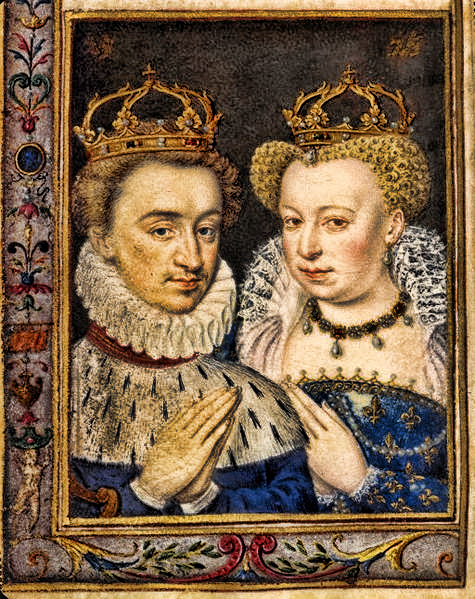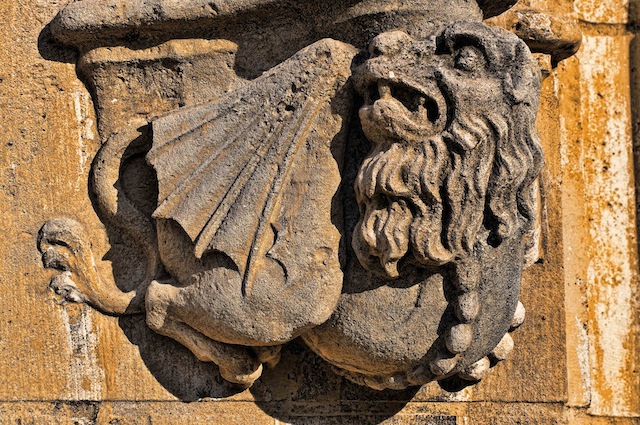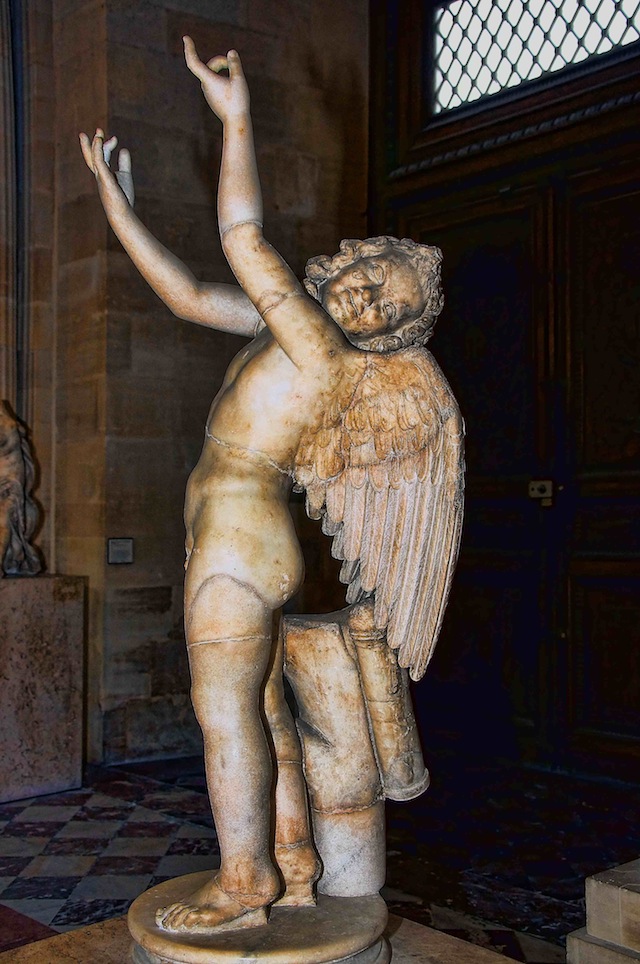Queen Margot
 05.4.2011
05.4.2011  Henri IV and Margot de Valois, adapted from Wikipedia
Henri IV and Margot de Valois, adapted from Wikipedia
I spent the weekend editing the memoir/novel of a friend named Margo, then met her Tuesday night for dinner to discuss the book. It’s called Vagrant, and it will be published soon. It’s the lusty version of Eat, Pray, Love. Do not buy it—I repeat—do not buy it, if you are a puritan. But if you are drawn to Paris, Hawaii, the quest for love and the quest for God, loneliness, beauty, poetry, sex, this is the book for you.
The sun and moon are in Taurus and that made me think of the goddess Aphrodite and lusty women. I’ve heard comments about how decadent the royal wedding of William and Kate was last week, but perhaps these commentators don’t know about the Renaissance Queen Margot, a truly lusty woman. (Again, you puritans can stop reading right now.)
Marguerite de Valois was born May 14, 1553. At the age of 19, she had an affair with Henri de Lorraine, Duc de Guise and wanted to marry him. But her mother, Catherine of Medici, had other plans for Margot.
This was an era of violent wars between Catholics and Protestants, and Catherine thought her daughter’s marriage ought to serve some practical political purpose, such as uniting the two warring religious factions.

On August 18, 1572, Margot was married off to Henri de Navarre, a Protestant Huguenot in Notre Dame Cathedral. Because Henri was not Catholic, he was kept out of the cathedral for most of the ceremony. (And so was his mother, Jeanne, who had just died, probably from putting on a pair of poisoned gloves that Catherine of Medici had given her as a wedding gift.)
Henri and Margot were both passionate people, just not about each other. Soon after their wedding, they took other lovers. But Margot protected Henri from being murdered six days later when Catherine of Medici called on her Catholic supporters to massacre the Huguenots gathered in Paris from all over France for the wedding. This is now known as the St. Bartholomew’s Day Massacre. Mothers-in-law can be difficult.

The two royals continued to protect and support each other, while enjoying busy love lives. But after some years, they grew apart, and Henri wanted to marry Marie de Medici. Queen Margot refused to divorce him, until the king gave her some money and allowed her to keep the title of Queen.
Reconciled to her former husband and his second wife, Marie de Medici, Queen Margaret became a patron of the arts and benefactress of the poor. She often helped plan events at court and nurtured the children of Henry IV and Marie. Rather like Bruce Willis and Demi Moore after their divorce.
Margot was known for her dazzling sense of style and fashion, and was a gifted poet and writer. Her memoir was published after her death in 1615. It was considered absolutely scandalous, and that is no easy thing to do, to scandalize the French.
Since I love outrageous people and lusty women (though you could say that Margot took it too far), some years ago, I wrote this persona poem, in her voice:
 L'Hôtel de Sens, in the Marais
L'Hôtel de Sens, in the Marais
QUEEN MARGOT
The French call me Chère Margot.
The doors of L'Hôtel de Sens
had grown too narrow
by the time they released me from prison.
 Doorway, L'Hôtel de Sens
Doorway, L'Hôtel de Sens
At 52, I’d grown stout
and bald, though it hardly mattered,
the declining power of skin balanced
by shapelier soul.
I had blond wigs fashioned
from the locks of my valets’ hair,
had the doors of the palace widened.
Though 18 years, it wasn’t so bad at Usson.
The jailer in my bed each night;
by day my memoir
about my lovers,
and prayers to Saint Jacob for release.
I’d never had illusions about
fairness between women and men.
I “knew love” at age 11,
courtesy of my brother,
the very one who incited the king
to imprison me for “insatiable desire,”
my husband, Henri IV—that’s right,
the one with 52 mistresses.
Life was full again. I built
a little chateau,
Henri remarried, left me alone
with my 20-year-old Count—
but then the 18-year-old carpenter’s son
arrived from Usson.
I returned from church one day,
my head full of songs for Saint Jacob,
when the Count shot my carpenter
before my very eyes.
Strangle him with my garters! I cried.
They removed his head. He’s the only dead lover
whose bit of heart is missing from the girdle
strung with lockets round my waist.

I moved to the chateau, finished
the garden convent I’d promised Jacob,
hired 14 Augustine fathers to sing
his praises round the clock.
I wrote all the lyrics and music myself. Jacob
was the only one who stayed with me to the end.
*
Richard and I began spending time in Paris every spring after our honeymoon here in 1997. We usually stayed in the apartment of friends, an apartment we now own. From here, we often walked across the Pont des Tournelles to the Marais. And just as you emerge from the Île St. Louis onto the Right Bank, there was a little chateau that intrigued me. I didn’t know why, but I slowed down and lingered in front of it each time we passed it.
A few years later, I finally stopped to read the plaque in front of it. L'Hôtel de Sens, it said. This was the chateau that Henri had provided for Margot when she was released from prison in Usson. Isn’t that strange? A place has a fascination for you and you later discover its connection to someone you’ve written about.
Even later, I was doing research on family names. My father’s middle name was Farrand. I traced it back to the Auvergne region in southern France, Ferrand, which later became the town of Clermont-Ferrand. In the volcanic mountains close by was the chateau Usson, where Margot spent 18 years writing her memoir. Is it possible that places and historical figures have resonance for us because the thread has come down in our DNA from our own ancestors? I think I read that a Ferrand lived in this castle, but I’m not sure. I’ve been looking for this genealogical information today and cannot find it. It may not be much of a link at all.
But the connection keeps coming up. I’ve just read that my new literary paramour, essayist Michel de Montaigne, was friends with Henri IV and Queen Margot. What an intricate web connects us all to one another, all of us, through all time, through books, imagination, DNA, kindred spirits.
(You can learn more about Queen Margot by reading Alexandre Dumas, pere’s 1845 novel, La Reine Margot, or see the 1994 French film La Reine Margot. And Shakespeare’s comedy, Love’s Labour’s Lost (1594-5) dramatizes an attempt at reconciliation in 1578 between Margaret and Henri. And Margot is played by Constance Talmadge in D. W. Griffiths’ 1916 film, Intolerance.
But you'll have to wait until 2012 to read Margo Berdeshevsky's Vagrant.)



Reader Comments (10)
"Paris Play" is gorgeous, Kaaren. Major congratulations to both you and Richard. Count me a reader henceforth. And a humblest "merci" for your words in the article about "Vagrant." Am honored to have found you as reader, editor, and friend.
Warmly,
La Reine Margo
(who is not a preying mantis, quand même, hence did not behead her lovers après sex, but the rest of the story is still so damn appealing :)
Kaaren, how lushly you write about that lusty queen! And how do the photos haunt your word images so perfectly. Eeerily beautiful. Cannot WAIT to read "Vagrant!" xo
And perhaps some of this wonderful journey had the music of Django
Reinhardt & Stepahne Grappelly with the Quintet of the Hot Club of
France in the background if not in real time at least in "re-memoried
time" I am guilty of supplying background music at times to memories
of other events - the insidious creep of movie culture. To imagine a
world all visual, no sound - beautiful and terrifying perhaps?
I had forgotten some of the turmoil of the religious wars in France so
thanks for the update on Margot and Henri.
Always with appreciation for these posts.
Love to you both
Jackson
Dear Jackson,
Thank you so much for your words. I like your sound track idea and with the help of a publisher friend may find a way to link to the music of Django Reinhardt and Stephane Grappelli.
I'm also reading Montaigne, and getting a sense of the violent wars raging all around him between Catholics and Huguenots during the Renaissance in France. This was the ancient Christian (Catholic) sense of the sacred battling against the growing rationalism of Protestant belief. And it was a losing battle. There's now very little sense of the sacred in western culture, though I think the first green leaves of a spring phase are appearing once again.
We love you,
Kaaren and Richard
Dear Cassandra,
Thank you so much! It's fun to write about (and photograph) lusty queens.
Congratulations on finishing your memoir. I toasted you over Thai food and champagne last night near the Canal St. Martin, with Richard and a friend.
Love,
Kaaren & Richard
Hi Margo,
Thank you for your warm heart and words. You know, I didn't set out to write about “Vagrant.” I had intended to post the poem and a few words about Queen Margot. Then I was struck by the synchronicity of having just spent two days editing a book by a lusty Margo, and it made me think of Chaucer's The Wife of Bath, who, along with Queen Margot, was also a lusty Taurus type.
And about those lovers’ hearts in lockets strung around her waist: I think most of them were killed by her brothers or by assassins hired by members of her family. She killed the count because he, in a jealous rage, killed her carpenter. So Queen Margot isn’t exactly a preying mantis. She just had a difficult family and did her best to live her fullest life, though the family put obstacles in her way from her earliest love. When she married Henri de Navarre, she wouldn’t say yes to the marriage vows, so her brother stepped in and spoke for her.
Thanks for your photos of the Catherine de Medici statue in the Jardin du Luxembourg.
Love,
Kaaren
Hi Kaaren and Richard:
I am catching up on Paris Play. Yes to synchronicity. Kaaren I love the way you are always reading symbols. The Queen Margot story is no different -- your path is before you -- but you bring your creative forces to the fore and that is how you seem to keep manifesting.
The colors of this set of photos are stunning Richard.
Bravo. Miss you,
Love Jon
"mothers-in-law can be difficult..." hahahaha... :D
Mon dieu! Poisoned gloves! An 18-year-old lover/carpenter murdered by a Count ~ in turn, murdered by a queen! Lovers, lovers, lovers... and a girdle of lockets holding hearts! Absolutely wild! Kaaren, your poem is so evocative, and Richard the photos are beautiful, as always. (Yes, the pull we feel to a place can be deep and not easily explained, but very real and very powerful. I know, Kaaren, ~ and perhaps, R, too? ~ that you are especially attuned to this!)
Do you know why Saint Jacob was Queen Margot's preferred saint?
Love to you both,
dawna
Hi Dawna,
Yes, that Catherine of Medici was one piece of work. Nixing Margot's desire to marry her first love, the Duc de Guise, was among the mildest of her acts.
You just gave me an idea for a post about places to which I've had passionate reactions, both positive and negative... Thank you!
I just ordered Alexandre Dumas Pere's novel, "Queen Margot," on the gift certificate you all gave me, at Shakespeare & Co. Maybe he will illuminate why Saint Jacob was her main man. I'll let you know.
Thank you, Dawna, for your insightful comments. I miss you. How's the novel coming?
Love,
Kaaren (& Richard)
Dear Jon,
I was fascinated to read that Jung discussed his concept of synchronicity with Einstein, and that they agreed that it was related to the theory of relativity. There is still so much to do in investigating and writing stories about the full implications of synchronicity and relativity, that I don't think that we'll ever come to the end of it.
Richard thanks you for your appreciation of his photos.
Hope to "see" you soon in our writers circle.
Love,
Kaaren & Richard